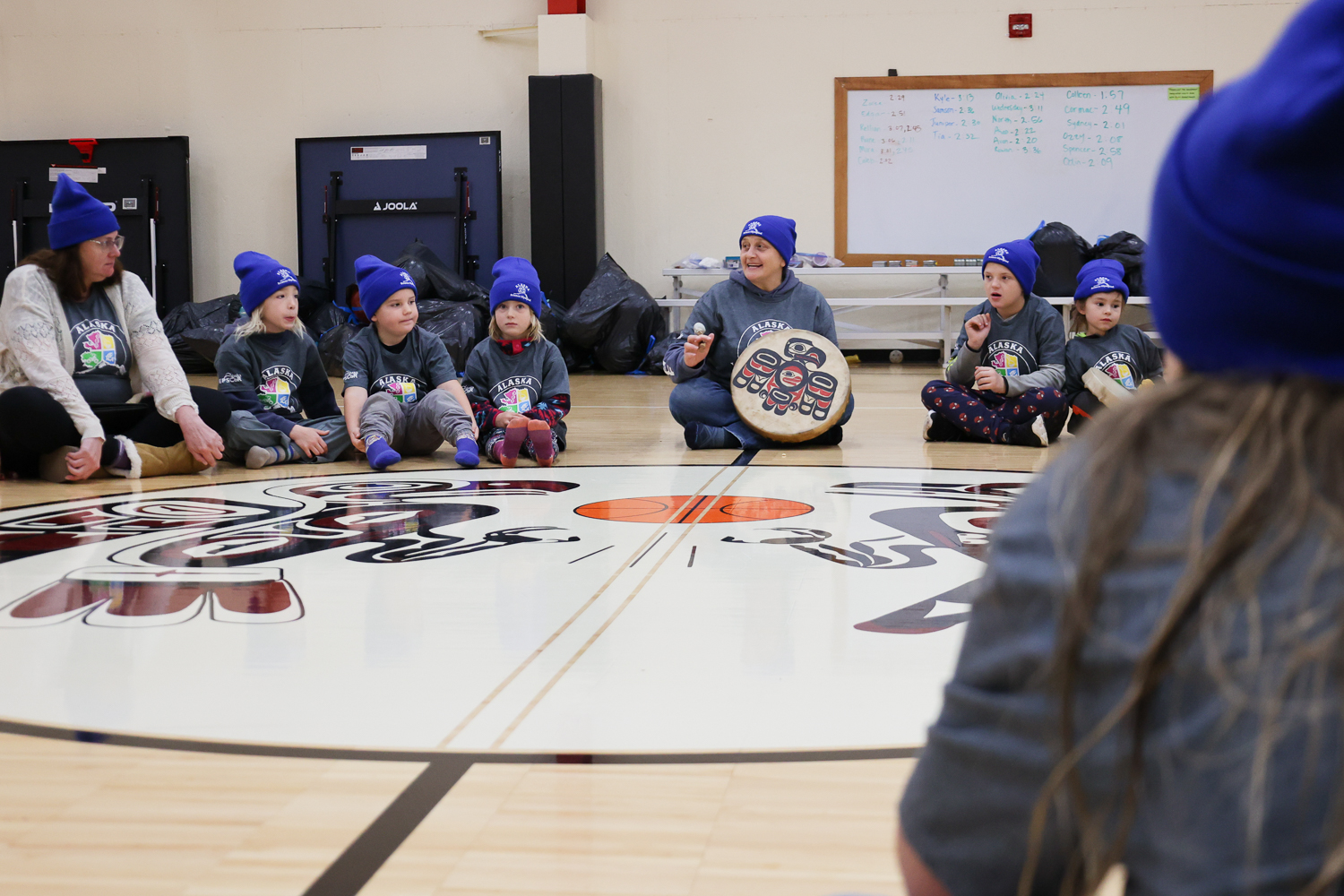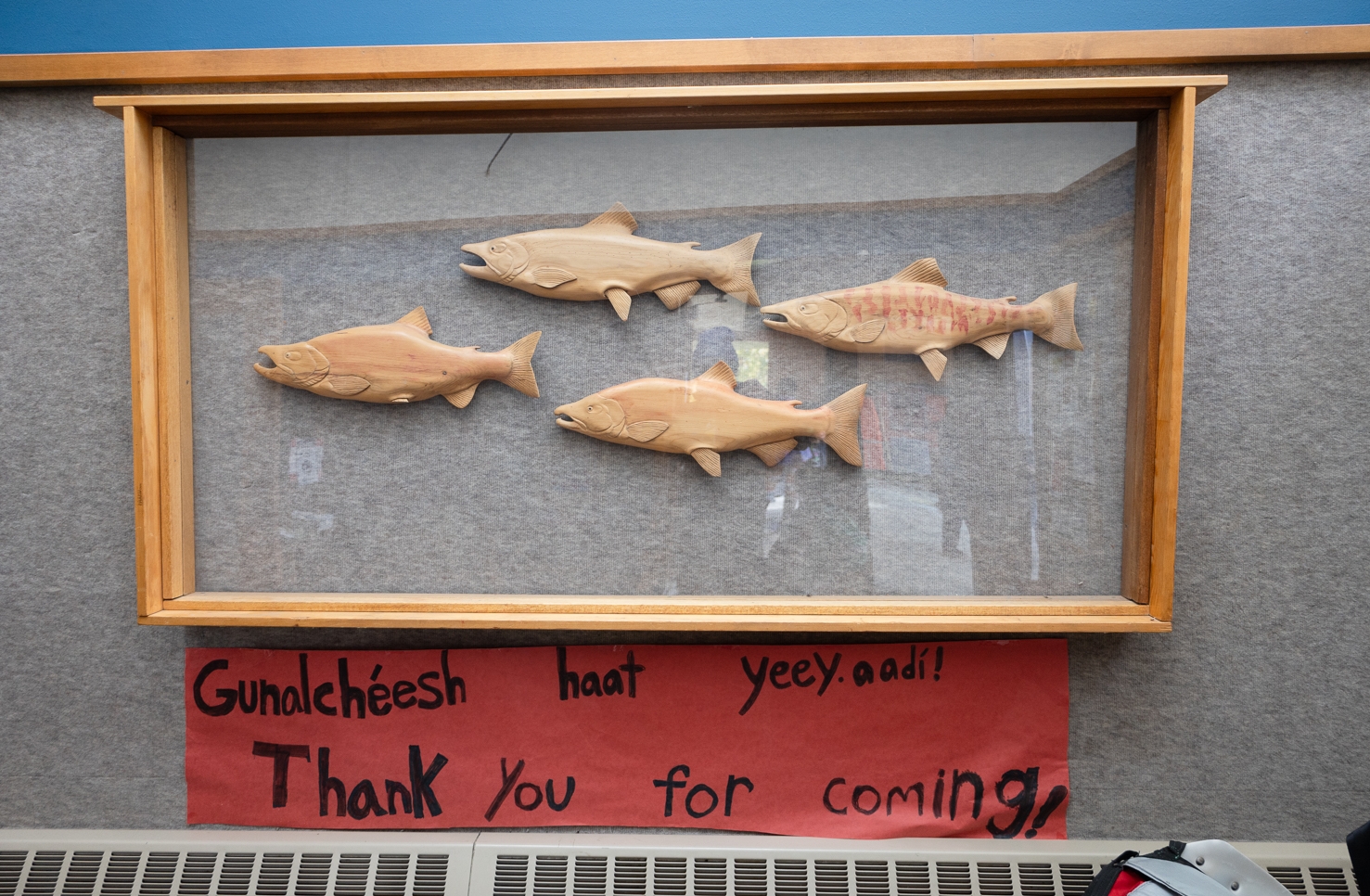Alaska Science Olympiad Visits Klukwan School
October 31, 2024

Klukwan School educator and Alaska EPSCoR advisory board member Justina Starzynski-Hotch leads students in a Tlingit chant sung daily at Klukwan School.
“We listen with our ears,” said Justina Starzynski-Hotch as she tugged on her earlobe. She said the phrase in Tlingit first, then in English as she sat in a circle of 33 children in the center of the gymnasium of the Klukwan School. Their cross-legged bodies circled around the school’s logo: a formline representation of Eagle and Raven, the two Tlingit moieties, leaping after a basketball.
“We listen with our eyes,” she said as she touched the corner of her eye. “We listen with our mouths. We listen with our bodies.”
Among the many hats worn by Starzynski-Hotch, she is a Tlingit language teacher and the STEPS coordinator at the Klukwan School. She has been involved in the village school for many years, and cares deeply for its survival. On September 19, she was substituting. And it was a special day – Science Olympiad day, thanks to so some special guests.

Cut paper letters taped to the window of a classroom at Klukwan School read, "Haa Een Aax'w, Our Family."
Starzynski-Hotch introduced the guests: staff and scientists from Alaska EPSCoR, a statewide research capacity-building program housed at the University of Alaska Fairbanks, and Nicole Ritzinger, K-12 STEM outreach director of the University of Alaska Anchorage College of Engineering, and former long-time resident of neighboring community, Haines.
In 2023, Starzynski-Hotch joined the Alaska EPSCoR Alaska Advisory Board. She had met Alaska EPSCoR kelp and seaweed scientist Schery Umanzor on a Zoom webinar about mariculture research. Starzynski-Hotch sought information on what potential there is for farming red seaweed. The connection inspired a whole branch of Alaska EPSCoR’s newest research project, Interface of Change, to further investigate questions around two important red seaweed species that grow in rocky coastal areas near Klukwan. In addition to collaborating on seaweed research, the connection planted a seed for future collaboration in Klukwan with community education centered around place-based observation and informal science learning, as well as looping in Klukwan School in Alaska Science Olympiad.

Alaska EPSCoR Juneau-based researchers Schery Umanzor (left) and Emily Whitney (right) volunteered for the Mini Olympiad event at Klukwan School, as well as a separate similar event in Seldovia. They assisted with scoring events, such as "Aviation" in which students created and tested paper airplane designs.
Alaska EPSCoR leads the organization of the Alaska Science Olympiad at the University of Fairbanks, a statewide tournament of science, technology, engineering, and math, or STEM, events in which middle school student teams from around Alaska compete.
But getting even participation from schools across the state is hugely challenging. For example, Klukwan is a twenty-minute drive north from Haines. Although Haines is connected to the Alcan Highway, Klukwan is deeply remote. Travelling from Klukwan to Fairbanks by car would be an unwieldy 625-mile drive, dipping in and out Canada. In a small rural village, the school has at times been faced with the challenge of maintaining enrollment.
In September, Alaska EPSCoR staff flew from Fairbanks to Anchorage to Juneau, and then travelled by ferry to host a special "Mini Olympiad" event at Klukwan School - a Science Olympiad-inspired event, condensed into a few competitions designed to engage the whole school. This visit is part of a series of similar events meant to bring the Science Olympiad experience to rural communities in Alaska.
That morning, Starzynski-Hotch led the children, whose ages ranged from three to thirteen, in their daily Tlingit chant, followed by a greeting and thanks for their visitors, who were invited to join the circle. Three of the Klukwan School students had a birthday that day, including a pair of twins who turned four. The circle sang a round of “Happy Birthday” before dispersing.
Big, black garbage bags of balloons began to unfurl around the gymnasium as the first Science Olympiad event was set up: Tower.

Klukwan students build a tower out of balloons.
The rules of "Tower" are simple: build the tallest tower you can with the materials provided. The students separated into teams of two to three with an adult available for loose guidance. Several teams were provided bags of balloons and tape. Two teams received red Solo cups and wooden tinker toy parts. Three teams received marshmallows and toothpicks. With their materials ready, the teams then quickly strategized how to build the most effective tower in a short amount of time. Some teams constructed their towers with full confidence in their approach beginning to end. Other teams found their design by puzzling an attempt or two, learning the best strategy in the process of building.
After recess, the children gathered their hand-built roller coasters for the next event. Ahead of Science Olympiad day, the students had prepared clever designs that made use of humble materials like cardboard, paper, tape, and popsicle sticks.

A student prepares to drop a marble in their roller coaster design made of painted pieces of cardboard, packaging tape, and sections of PVC pipe.
Each roller coaster team had a turn to place their design on a table and watch as a marble ran through the track. The roller coaster designs that carried the marble from beginning to end closest to ten seconds received the most points.
Teams also competed on best, farthest-flying paper airplane design for the “Aviation” event, followed by an event called “Write It, Do It,” which challenges students' explanation and interpretation skills. For “Write It, Do It,” part of the team received a final design of assembled materials including plastic cups and pipe cleaners, which they had to then describe in writing for the other part of the team to recreate the design.

Justina Starzynski-Hotch and a student read the written description for the "Write It, Do It" Science Olympiad challenge. The team must interpret the directions to correctly recreate a design.
“Can we do this again tomorrow?" one of the students asked. The adults looked around at each other, knowing that this was of course a one-day event, with the Alaska Science Olympiad team's future ability to return is yet unknown. But now, empowered by the experience, the Klukwan School students and teachers can engage in Science Olympiad activities on their own in the meantime. With enough practice and support, they look forward to eventually traveling to Fairbanks to compete in the statewide Alaska Science Olympiad in the future.

A sign by the front door of Klukwan School reads, "Gunalchéesh haat yeey.aadí! Thank you for coming!"

